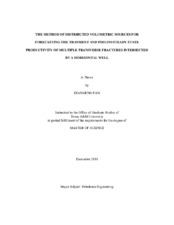| dc.description.abstract | This work of well performance modeling is focused on solving problems of transient and pseudo-steady state fluid flow in a rectilinear closed boundaries reservoir. This model has been applied to predict and to optimize gas production from a horizontal well intercepted by multiple transverse fractures in a bounded reservoir, and it also provides well-testing solutions.
The well performance model is designed to provide enhanced efficiency with the same reliability for pressure transient analysis, and well performance prediction, especially in complex well fracture configuration. The principle is to simplify the calculation of the pressure response to an instantaneous withdraw, which happens in other fractures, within a shorter computational time. This pressure response is substituted with the interaction between the two whole fractures. This method is validated through comparison to results of rigorous Distributed Volumetric Sources (DVS) method in simple symmetric fracture configuration, and to results of field production data for complex well/fracture configuration of a tight gas reservoir. The results show a good agreement in both ways.
This model indicates the capability to handle the situations, such as: various well drainages, asymmetry of the fracture wings, and curved horizontal well. The advantage of this well performance model is to provide faster processing - reducing the computational time as the number of fractures increase. Also, this approach is able to be applied as an optimization and screening tool to obtain the best fracture configurations for reservoir development of economically marginal fields, in terms of the number and dimensions of fractures per well, also with external economic and operational constraints. | en |


